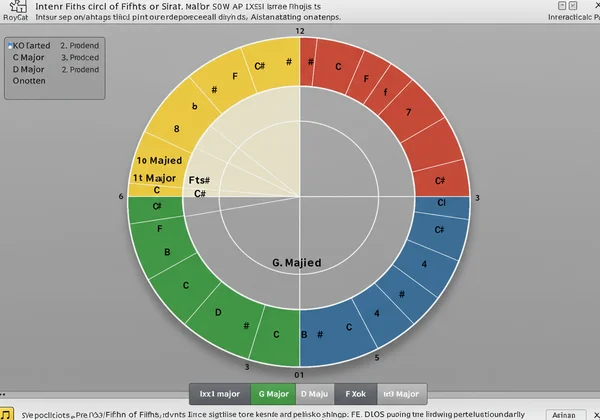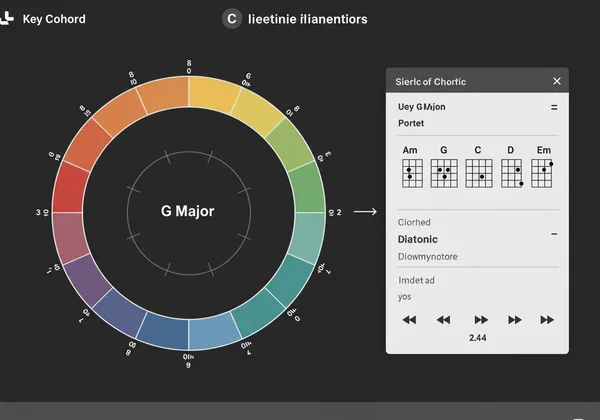Circle of Fifths Exercises: Boost Your Music Skills Daily
The Circle of Fifths. For many musicians, this single diagram represents a major hurdle in their music theory journey. It can feel like a complex, abstract map that’s hard to memorize and even harder to apply. But what if you could transform it from a source of confusion into your most powerful practice partner? That's where targeted, daily circle of fifths exercises become your game-changer. How to use the circle of fifths to unlock your creative potential? The key isn't endless memorization, but active, hands-on engagement.
Whether you're a music student staring down a theory exam, a songwriter searching for that perfect chord, or an instrumentalist eager to improvise with confidence, the Circle of Fifths holds the answers. Static charts in textbooks can only take you so far. To truly internalize these concepts, you need to see, hear, and interact with them. This guide provides practical, daily exercises designed to be used with an interactive tool, turning theory into tangible skill. Get ready to make your practice sessions more efficient, engaging, and effective with our interactive circle today.

Master Key Signatures with Interactive Drills
Forgetting how many sharps are in B major or flats in A♭ major is a common frustration. These interactive drills are designed to build instant recall, making key signatures second nature. Forget rote learning; it's time to play your way to mastery.
The Clockwise Key Signature Drill: Memorizing Sharps & Flats
The order of sharps and flats isn't random; it follows a perfect pattern on the circle. This exercise makes that pattern intuitive.
Start by visiting our circle of fifths chart. Begin at the top with C Major (no sharps or flats). Click one step clockwise to G Major. Notice that it adds one sharp: F♯. Click again to D Major. You'll see it keeps the F♯ and adds a second sharp, C♯. Continue clicking clockwise around the circle—A, E, B, F♯, C♯—and watch as each new key adds one more sharp in a predictable sequence (F, C, G, D, A, E, B).
Now, go back to C and move counter-clockwise for the flats. Click on F Major (one flat: B♭), then B♭ Major (two flats: B♭, E♭), and so on. Spending just two minutes a day on this drill will solidify the pattern in your mind far faster than flashcards ever could.

Identifying Relative Minors: Connecting the Inner Circle
Every major key has a relative minor, which shares the exact same key signature. Finding it is simple on the circle, and this exercise builds that instant connection.
Look at the interactive tool. Click on any major key on the outer ring, for example, E♭ Major (3 flats). The tool will automatically highlight its relative minor on the inner ring: C minor. You’ll see that C minor also has three flats. Try another: click on A Major (3 sharps). The tool instantly shows you its relative, F♯ minor. This visual connection is crucial for understanding song structures and modulation. Practice by picking a major key and naming its relative minor before you click to check your answer.
Instant Key Recognition: Test Your Speed with Our Tool
This drill turns theory into a fun game. On our interactive tool, you have the option to hide the key signatures. Activate this feature and click on any random key on the circle. Before the tool reveals the answer, try to name the sharps or flats associated with it. For example, if you land on E Major, say "Four sharps: F♯, C♯, G♯, D♯" out loud. Then, click to reveal the key signature and check your accuracy. This active recall method is a scientifically proven way to strengthen memory. Challenge yourself to get faster and more accurate each day.
Elevate Your Chord Progressions & Ear Training
Understanding key signatures is just the first step. The true magic unfolds as you apply the Circle of Fifths to build, hear, and manipulate chord progressions. This is where theory seamlessly transitions into actual music-making.
Building Diatonic Chords: Hear the Harmony in Action
What chords belong in the key of G Major? Or B♭ minor? Instead of calculating them, you can see and hear them instantly.
Click on any key in our free tool. Let's use G Major as an example. The tool will immediately display all the diatonic chords for that key: G (I), Am (ii), Bm (iii), C (IV), D (V), and Em (vi). But here's the best part: you can click on each of these chords to hear what they sound like. This auditory feedback is a game-changer, connecting the theoretical names to the actual sounds of harmony. Spend time clicking through the chords of different keys to train your ear to recognize the sound of a subdominant (IV) or dominant (V) chord.

Practicing Common Chord Progressions: II-V-I & Beyond
The ii-V-I is one of the most common and powerful chord progressions in jazz, pop, and classical music. The Circle of Fifths makes finding and understanding it incredibly simple.
Look at the circle. Pick a "I" chord, which will be your tonic or home key—let's choose C Major. The "V" chord (G) is always one step clockwise. The "ii" chord (Dm) is directly clockwise from the "V." They sit together in a neat little cluster. Using the tool, you can click on C, see that its ii is Dm and its V is G, and then listen to the Dm - G - C progression. This visual and auditory reinforcement demystifies why certain progressions sound so resolved and satisfying.
Transposition Made Easy: Shift Keys Instantly
A singer asks you to play your song in A Major instead of G Major. Don't panic! Transposing is a common task for musicians, and the Circle of Fifths makes it painless.
Imagine your song uses a I-IV-V-vi progression in G Major (G - C - D - Em). To transpose it, simply go to the interactive tool and click on your new key, A Major. The tool will immediately show you the new diatonic chords. Your new I-IV-V-vi progression is A - D - E - F♯m. There's no complex mental math involved. You can instantly see the correct chords and even click to hear them, ensuring your transposed progression sounds right before you play a single note on your instrument.

Integrate Daily Circle of Fifths Practice for Lasting Impact
Consistency is more important than intensity. A short, focused daily practice session will yield far greater results than a long, infrequent cramming session. Integrating these exercises into your routine will build deep, lasting musical intuition.
Setting Up Your Routine: Just 10 Minutes a Day
You don't need hours. Commit to just ten minutes of focused practice each day. Here is a sample routine you can adapt:
- Minutes 1-3: Key Signature Speed Run. Use the clockwise/counter-clockwise drill to quickly cycle through all the major key signatures.
- Minutes 4-7: Chord Progression Explorer. Pick a key for the day. Identify its primary chords (I, IV, V) and its relative minor. Play a ii-V-I progression and listen to how it resolves.
- Minutes 8-10: Transposition Challenge. Take a simple progression you know (like C-G-Am-F) and use the tool to transpose it to one new key each day.
Tracking Your Musical Progress with Interactive Tools
How do you know you're improving? Use the tool's features to help you. After mastering the chords in a particularly tricky key, like F♯ Major, use the PDF export feature to save a copy of the chart. You can print these out and build a binder of keys you are confident with. This creates a tangible record of your progress. As you get more comfortable, use the "hide key signature" function as a self-quiz and keep a mental note of how much faster you can identify keys compared to last week. This transforms your practice from a chore into a rewarding journey of mastering music theory.
Your Next Steps to Mastering Music Theory
The Circle of Fifths is not just a diagram to be memorized; it's a dynamic, practical resource waiting to be explored. By dedicating a small amount of time each day to these interactive exercises, you are actively rewiring your brain for musical fluency. You will find yourself identifying keys faster, writing more compelling chord progressions, and improvising with a newfound sense of freedom and confidence.
The journey to musical mastery is built on consistent, intelligent practice. The barrier of complex music theory is now lower than ever. Stop looking at the Circle of Fifths as an obstacle and start using it as the incredible tool it is.
Ready to begin? Head over to our interactive tool and try the first exercise right now. Your future musical self will thank you.
Frequently Asked Questions About Circle of Fifths Exercises
How to use the Circle of Fifths tool for daily practice?
It's all about interaction! The best approach is to actively use our tool: click through keys clockwise and counter-clockwise, and you'll master key signatures in no time. Select a key to instantly see all its diatonic chords, use the audio feature for ear training, and finally, use it to transpose familiar chord progressions into new keys effortlessly.
What are the main benefits of Circle of Fifths exercises?
Consistent practice with these exercises quickly leads to rapid memorization of all 12 key signatures. You'll gain a deeper understanding of chord relationships, the ability to write more sophisticated chord progressions, and the confidence to transpose music on the fly. Essentially, it fundamentally elevates your overall musicianship and improvisation skills.
How can the Circle of Fifths help with memorizing key signatures?
Its visual and logical layout is the key. Moving clockwise adds a sharp, and moving counter-clockwise adds a flat. By using an interactive tool to perform these movements daily, you turn abstract data into a memorable, kinetic process, which is far more effective than staring at a static chart.
Can the Circle of Fifths improve my chord progression understanding?
Absolutely. It visually organizes chords based on their harmonic function. You can easily spot the strongest relationships, like the V-I (dominant to tonic), and discover common patterns like the ii-V-I used in countless songs. Hearing these progressions with our tool connects the theory directly to the sound.
Is the Circle of Fifths tool free for all these exercises?
Yes, it is completely free. Our mission is to make music theory accessible to everyone. The interactive Circle of Fifths tool, with all its features including key signature display, diatonic chord generation, audio playback, and PDF export, is available for free to all students, teachers, and musicians who want to explore the tool.